Key takeaways:
- Palestinian theater acts as a powerful medium for expressing communal identity, resilience, and the complexities of the Palestinian experience.
- Cultural exchange fosters empathy and creativity, transforming perceptions and encouraging collaborative artistic expression across diverse communities.
- The Palestinian Conference serves as a vital platform for dialogue and innovation, connecting global perspectives to enrich Palestinian narratives through arts.
- Future connections in Palestinian theater will leverage digital platforms and emphasize youth engagement, promoting diverse storytelling and cultural revitalization.
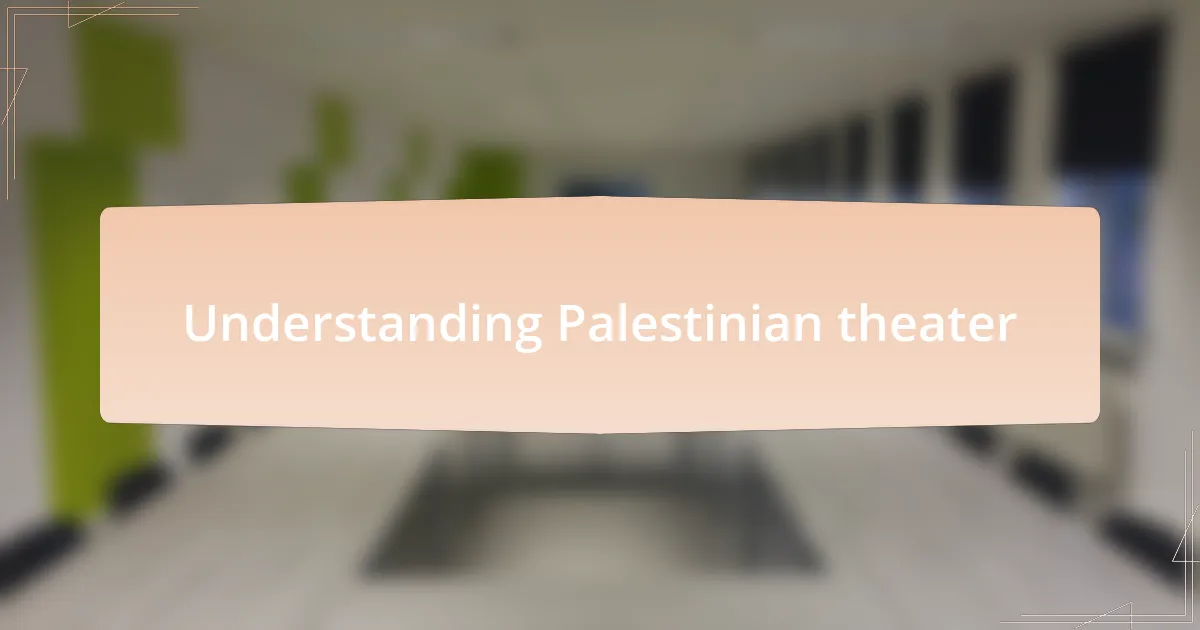
Understanding Palestinian theater
Palestinian theater is a powerful medium that reflects the complex social and political realities of the Palestinian experience. I remember attending a performance that transformed a seemingly simple story into a profound commentary on identity and resilience. How does a single performance encapsulate such deep emotions and realities? The answer often lies in the shared memories and dreams of a community navigating its struggle for recognition.
In many ways, Palestinian theater serves as a voice for the voiceless, a platform where personal stories intersect with collective narratives. I once spoke with a young actor who described how their roles became a means of expressing not just individual pain but also hope for future generations. Isn’t it fascinating how art can bridge the gap between personal experience and universal themes, making us feel less alone in our struggles?
The evolution of this theater form is marked by vibrant storytelling that incorporates traditional elements and contemporary issues. I have seen how performances invite the audience to engage actively, provoke thought, and sometimes challenge preconceived notions. This interaction raises the question: what does it mean to witness a story that mirrors our own or reveals the lives of others? For many, it fosters not just understanding but a profound sense of empathy and connection.
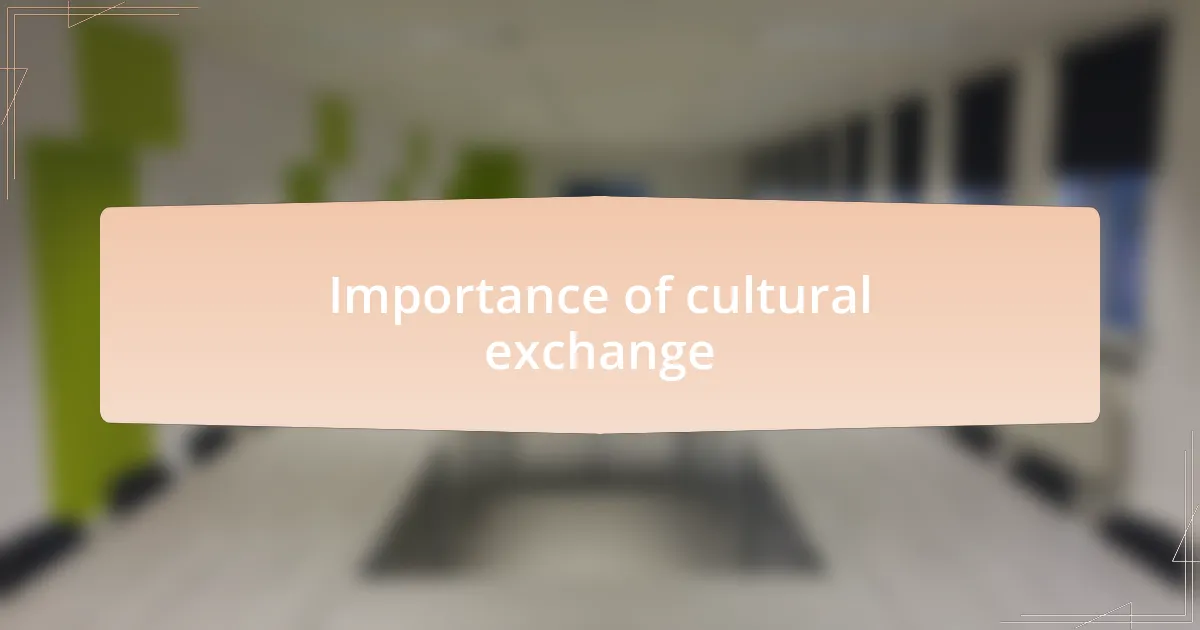
Importance of cultural exchange
Cultural exchange is vital as it nurtures mutual understanding among diverse communities. I remember a time at a cultural festival where I witnessed a blend of Palestinian music and dance with other global art forms. This amalgamation not only celebrated our differences but highlighted the threads of commonality that unite us, leading to conversations that broke down barriers.
When people engage in cultural exchange, it often transforms perceptions. I met an artist who traveled to Palestine and shared their reflections on how witnessing local theater changed their understanding of resilience and creativity. Such experiences often lead to a shift in worldview—don’t you think that exposure to different cultural expressions can encourage empathy in ways that mere words cannot?
Moreover, exchanging art fosters creativity and innovation. I participated in a collaborative project where we explored Palestinian narratives through various artistic mediums. This collaboration was not just about sharing stories; it sparked new ideas and inspired participants to think beyond their comfort zones. How often do we find ourselves invigorated by the perspectives of others, encouraging us to express our identities in fresh, imaginative ways?

Overview of the Palestinian Conference
The Palestinian Conference serves as a platform for fostering dialogue and collaboration among artists, scholars, and community members passionate about Palestinian culture. I remember attending the conference last year and feeling the palpable energy in the air. It was inspiring to see so many people united by a shared goal: to elevate Palestinian narratives through the arts.
During the event, I participated in several workshops that delved into the intersection of theater and cultural identity. One particular session focused on the role of storytelling in preserving heritage. The facilitator asked us to reflect on how personal stories shape our community’s history. I realized that sharing our experiences, both joyful and painful, can create a tapestry of resilience that uplifts not just individuals, but entire communities. Isn’t it powerful how our voices can resonate beyond borders?
Additionally, the conference highlights the importance of international partnerships. Connecting with attendees from various countries provided me with insights into how global perspectives can enrich the Palestinian narrative. I recall chatting with a filmmaker who was eager to collaborate on a project that spotlighted everyday life in Palestine. These cross-cultural exchanges not only deepen understanding but also spark innovative ideas that can drive the Palestinian arts scene forward.
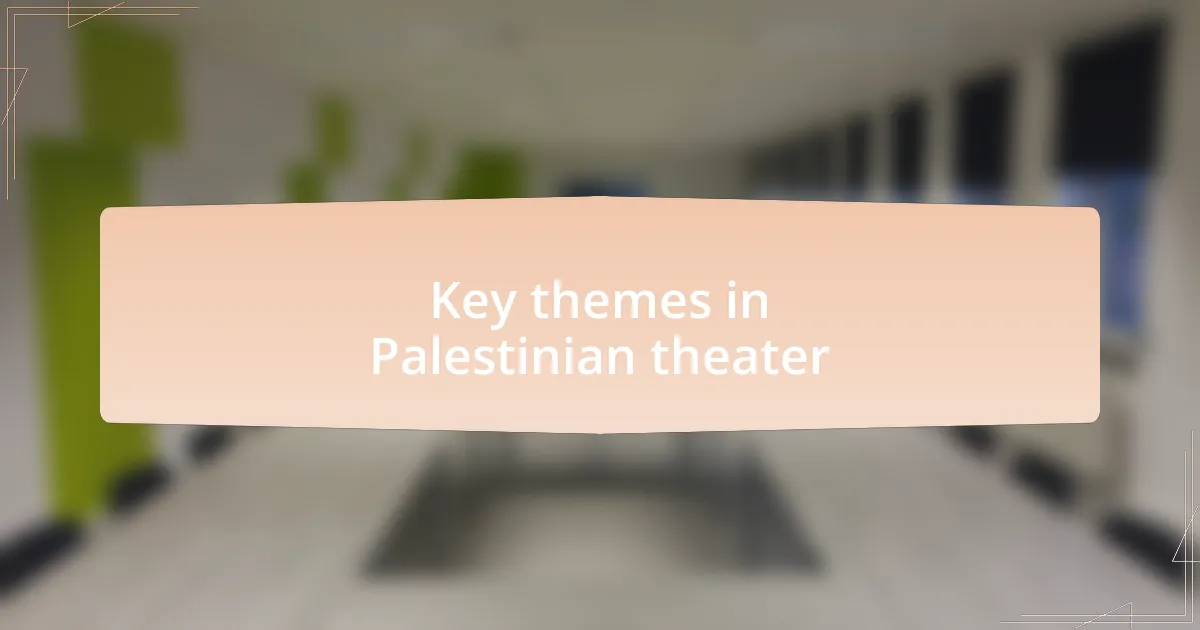
Key themes in Palestinian theater
One of the most poignant themes in Palestinian theater is the exploration of displacement and loss. I’ve witnessed firsthand how performers delve into the emotional weight of these experiences, transforming pain into powerful narratives that resonate with audiences. Isn’t it fascinating how a story can evoke feelings of longing and connection, even when shared across vast distances?
Another significant theme is resilience and resistance. Through immersive performances, artists articulate the struggle for identity and freedom. I remember attending a poignant play where the characters faced insurmountable challenges yet remained unyielding in their hope. This portrayal ignited discussions among audience members about what resilience means in our daily lives. Can theater serve as a mirror reflecting our shared struggles and aspirations?
Furthermore, the theme of community plays a central role in Palestinian theater. I’ve often noticed how collaborations among actors, writers, and directors create a sense of belonging and solidarity. A memorable moment for me was during a play where the cast invited audience members to share their own stories of struggle and triumph, blurring the lines between performer and spectator. This interaction highlighted how theater can be a communal space for healing and understanding, don’t you think?
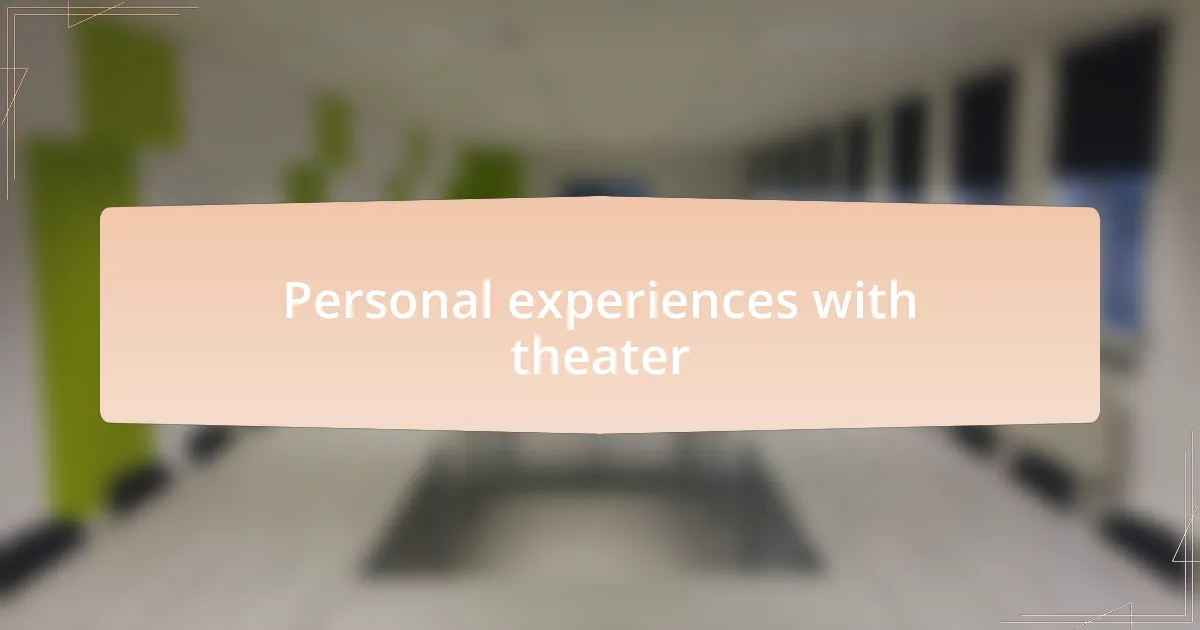
Personal experiences with theater
Experiencing theater has always been a deeply personal journey for me. I vividly recall my first experience in a small local theater, where the actors passionately performed a play centered on familial bonds fractured by political strife. As I watched, I felt an overwhelming sense of empathy, as if their stories were pulling at threads within my own heart. Have you ever had a moment in the theater where the narrative felt so close to home that it left you breathless?
One performance that stayed with me was a gripping tale of youth navigating their identity amidst uncertainty. I remember sitting in the audience, surrounded by strangers, yet feeling a profound connection as the characters’ voices wove through our shared experiences. Their struggles echoed my own fears and dreams, reminding me that our personal stories often intersect in unexpected ways. Isn’t it amazing how a mere performance can create such a strong bond among us?
The theater also became a sanctuary for dialogue in my life. I once participated in a post-performance discussion that spiraled into a heartfelt exchange about dreams and aspirations. It was remarkable to share those moments of vulnerability with others who had different backgrounds yet similar hopes. This communal experience underscored the power of theater—not just to entertain, but to foster deep connections and understanding. How often do we find spaces where we can truly listen to each other?
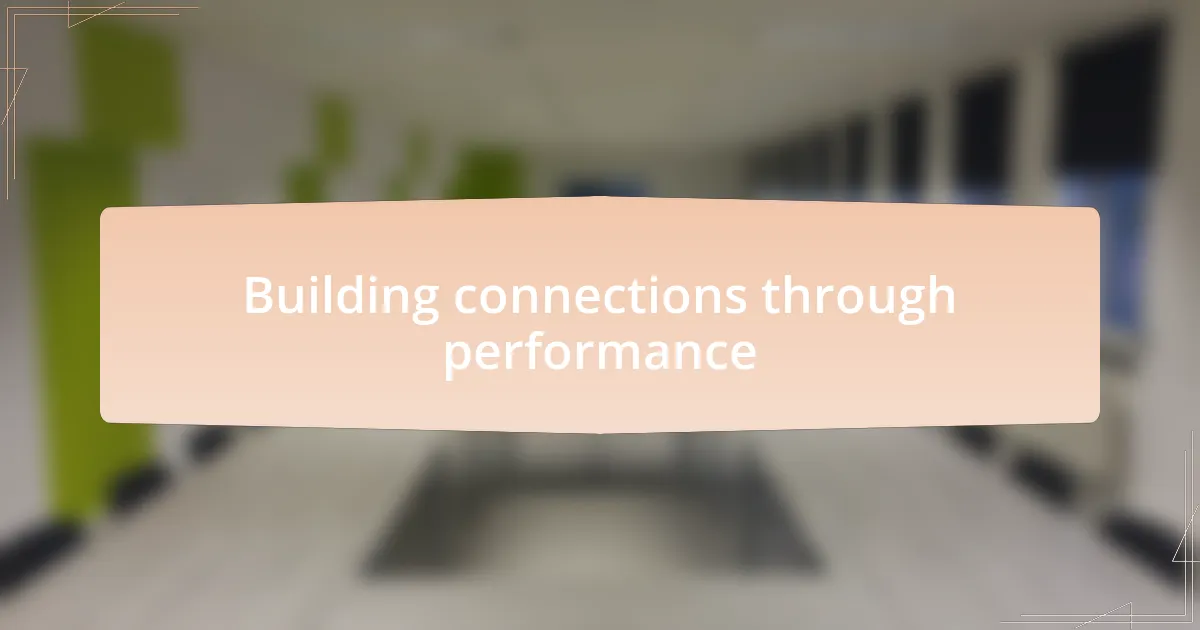
Building connections through performance
Building connections through performance is a transformative experience that goes beyond mere entertainment. I recall attending a play where the cast was a mix of seasoned actors and fresh talent from different backgrounds. As they shared their unique stories on stage, they bridged gaps between cultures and generations, creating a tapestry of connection that resonated deeply with everyone present. Isn’t it fascinating how a shared narrative can dismantle barriers and foster understanding among diverse audiences?
One evening, I found myself in a workshop where we acted out our experiences regarding displacement and belonging. We were strangers at first, each hesitant, but as we began to share our stories through performance, laughter and tears intertwined. The catharsis was palpable, transforming our differences into threads of unity. Have you experienced a moment where vulnerability in a creative space brought people together in unexpected ways?
Furthermore, the impact of collective storytelling cannot be understated. After watching a powerful production about resilience in the face of adversity, the audience engaged in a dialogue that lasted long after the curtain fell. We exchanged personal stories, highlighting how the characters’ struggles resonated with our own lives. It struck me then how performance has a unique ability to cultivate empathy, igniting conversations that can lead to real-world connections. How often do we find ourselves longing for such moments of genuine exchange?
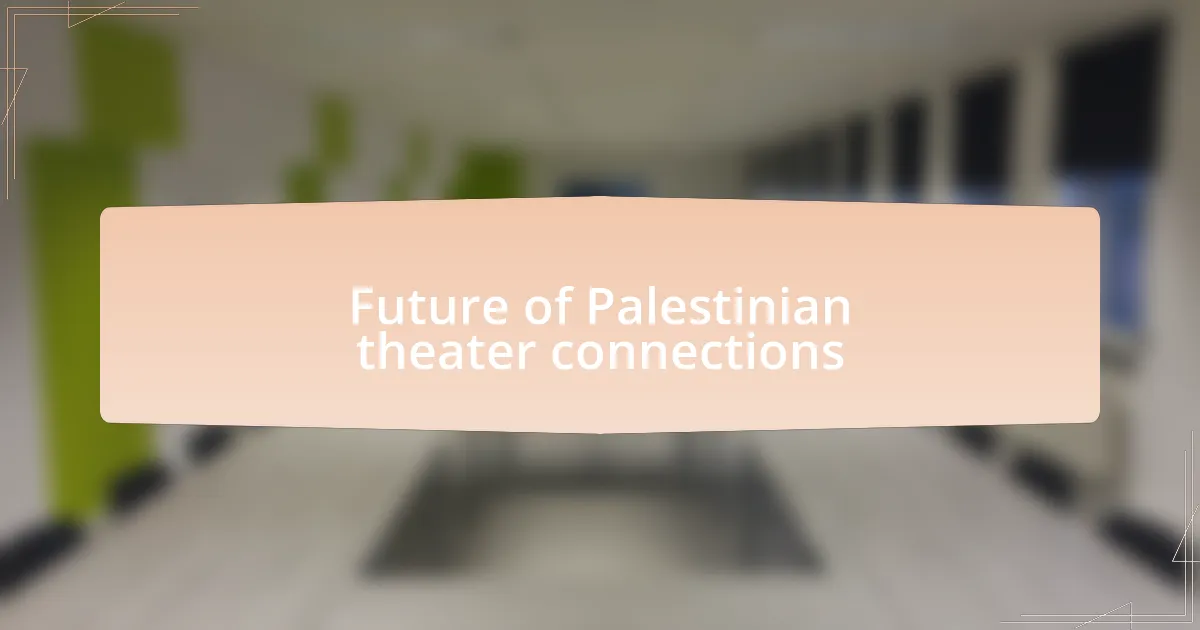
Future of Palestinian theater connections
The future of Palestinian theater connections holds immense promise as digital platforms revolutionize how we share and experience performances. I remember watching a stunning online production that featured artists from Palestine and the diaspora, connecting disparate communities through shared narratives. It was remarkable to see how technology can offer a virtual stage, breaking geographical barriers—how often do we find ourselves connecting more profoundly through a screen than we ever thought possible?
As collaboration becomes more commonplace among Palestinian theater artists, we can anticipate an exciting fusion of diverse influences. A few years ago, I participated in a collaborative playwriting event that brought together writers from various backgrounds, each adding their unique voice to the narrative. This blend not only enriched the stories being told but also highlighted the collective strength and resilience of our identities. How will these collaborations pave the way for culturally rich productions that reflect our evolving realities?
Moreover, the emphasis on youth engagement in theater is crucial for the future of these connections. After volunteering at a youth theater workshop, I witnessed firsthand the enthusiasm and creativity of young actors. Their innovative interpretations of traditional stories infused a fresh perspective that truly revitalized our cultural narratives. What if, by nurturing this passion, we empower the next generation to take center stage in shaping Palestinian theater?